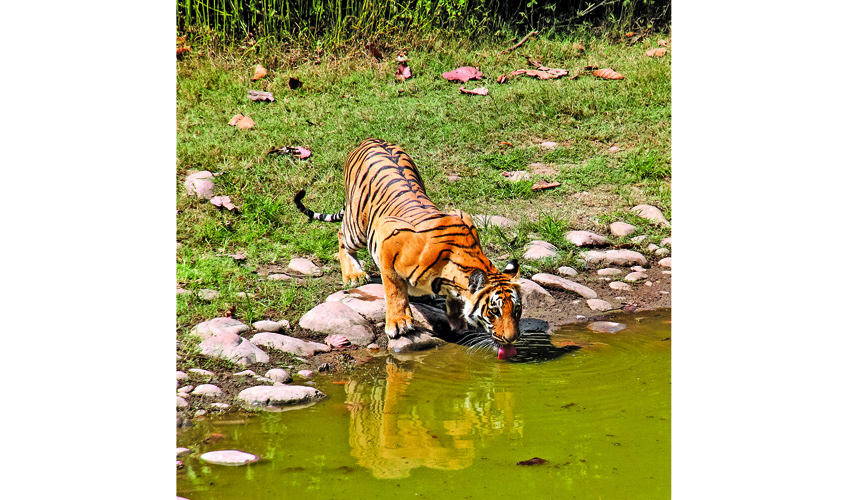Corbett National Park: Domain of the wild
Text by: Ashima Kumar
Photographs by: Dushyant Parasher
Published by: Konark Publishers Pvt. Ltd.
Pages: 188
Price: Rs 1,995
I had always associated Konark Publishers with general books on personalities, politics, policies oreven poetry at times; so when this handsome and well produced pictorial book on Corbett National Park arrived for a review I was pleasantly surprised. Author Ashima Kumar did not ring a bell, but the photographer Dushyant Parasher who has so many pictorial books to his credit was of course a familiar name. If this book ever needed an endorsement, it was there in the form of a Foreword by Bittu Sahgal, Editor Sanctuary Asia, and one of the most genuinely concerned environmentalists of our times.
As books by Jim Corbett certainly outnumber books ‘on’ Corbett National Park, this volume fills a gap that existed ever since the last one on this subject published by Sanctuary Asia went out-of-stock a few years ago.
Corbett National parkis not only one of the finest nature reserves of our country,in author’s words, “It is also the first milestone of conservation historyof India.” Corbett: Domain of the Wild is a coffee table book that celebrates this India’s wild heritage, in aesthetical images and a complementing well researched text. A collection of vivid photographs capture the true essence of the Park and compels one to turn the page for more awe-inspiring wildlife and environmental images.Parallel to the pictorial content the author weaves the story of its natural history and the changes it underwent through the ages.
Jim Corbett after whom the park has finally been named, was a hunter turned conservationist, photographer and writer. He lived in the area close to the park at Kaladungi and extensively wrote about the animals, the forest and the people who lived here in his many books that became popular worldwide.
Jim Corbett after whom the park has finally been named, was a hunter turned conservationist, photographer and writer. He lived in the area close to the park at Kaladungi and extensively wrote about the animals, the forest and the people who lived here in his many books that became popular worldwide. Today there are not many books that talk about the biodiversity of the park, its history, best seasons

In sixteen chapters the book delivers the impact of hunting and deforestation followed by the dawn of conservation and the declaring of this area as a national park. Its biodiversity and the zones it is divided into for better wildlife protection. The book also talks about the many threats to wildlife and the environment due to man’s self-centered ideas of lopsided development.
While the book has enough material in terms of text and images to cater to the usual urban tiger-centric visitors, it also draws attention to the “small wonders of nature” that are as fascinating and important in the delicate web of life. It is a land rich in biodiversity where nature is in perfect harmony and balance. Corbett is a mosaic of dense forest, grasslands, hilly areas and riverine landscape. It is this diversity of terrain that makes it a great habitat for a plethora of wildlife.
The author and photographer have on the one hand show cased the grandeur and beauty of Corbett and on the other drawn attention to the threats to our environment. With climate change no longer a topic of debate but a very real threat looming large over our heads the book emphasizes that the importance of safe guarding forests cannot be under estimated. A forest left undisturbed will regenerate, recuperate the environment and literally rescue us from the harmful effects of climate change. Trees not only absorb carbon from the atmosphere but also produce the much needed oxygen that is vital for the survival of us humans.
Corbett is a protected forest but the threats to wild life are many. Poaching, being one of them. The forest needs the tiger just as much as the tiger needs the forest. Human life too is only sustainable if we live in harmony with nature. I will leave you with a lovely quote from the book.
‘In the Indian way of thinking, Earth, Sky, Air, Fire and water (Bhumi, Gagan, Vayu, Agni and Neer) are the five fundamental constituents of nature. ‘Bhagwan’— the generic term for God in Hindi is nothing but an abbreviation of these five words (Bh+Ga+wa+Aa+Na) which simply means that according to ancient Indian wisdom, “Nature is God”.
Mohit Aggarwal is a conservationist and an eco-hotelier

